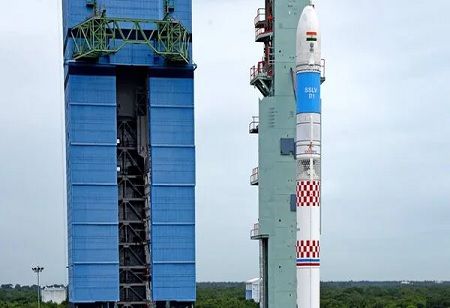
ISRO's SSLV Set for Final Development Flight Today, EOS-08 to Be Deployed

 The Indian Space Research Organisation (ISRO) has initiated the countdown for the third and final developmental flight of the Small Satellite Launch Vehicle (SSLV) mission. Set to launch on Friday at 9:19 am from the Satish Dhawan Space Centre in Sriharikota, Andhra Pradesh, this mission represents the completion of the SSLV's developmental phase. The launch was initially scheduled for August 15.
The Indian Space Research Organisation (ISRO) has initiated the countdown for the third and final developmental flight of the Small Satellite Launch Vehicle (SSLV) mission. Set to launch on Friday at 9:19 am from the Satish Dhawan Space Centre in Sriharikota, Andhra Pradesh, this mission represents the completion of the SSLV's developmental phase. The launch was initially scheduled for August 15.
The 34-meter rocket will carry a 175.5-kilogram Earth Observation Satellite (EOS-8) equipped with three payloads: an electro-optical infrared payload, a global navigation satellite system reflectometry payload, and a silicon carbide ultraviolet dosimeter. The primary goals of the EOS-8 mission include developing a microsatellite, creating payload instruments compatible with the microsatellite bus, and incorporating new technologies for future satellites, according to the space agency based in Bengaluru.
The satellite is equipped to capture images both day and night for various applications, including surveillance, disaster monitoring, and environmental assessments. The primary payload, EOIR, is specifically designed to capture images in the Mid-Wave Infrared (MWIR) and Long-Wave Infrared (LWIR) bands, enabling round-the-clock imaging. It is intended for use in satellite-based surveillance, disaster monitoring, environmental evaluations, fire detection, volcanic activity observation, and monitoring industrial and power plant disasters.
The second payload, GNSS-R, demonstrates the capability of GNSS-R-based remote sensing for a range of applications such as ocean surface wind analysis, soil moisture assessment, cryosphere studies over the Himalayan region, flood detection, and the monitoring of inland water bodies. The third payload, a SiC UV Dosimeter, monitors UV irradiance at the viewport of the Crew Module in the Gaganyaan Mission and acts as a high-dose alarm sensor for gamma radiation.
ISRO has carried out three test flights of the SSLV this year, including the PSLV-C58/XpoSat in January and the GSLV-F14/INSAT-3DS in February. Standing at about 34 meters tall with a payload capacity of 500 kg, the SSLV is engineered as a cost-effective and adaptable launch vehicle for small satellites. The successful conclusion of this mission will allow the SSLV to move into full operational status, facilitating the launch of small satellites for both the Indian industry and ISRO's commercial arm, NewSpace India Limited.